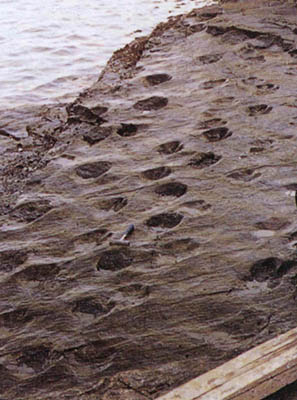크로마뇽인들이 2만5천여년전에 오늘날의 프랑스와 스페인에 있는 동굴 깊숙이 채색 동물화를 그렸을때 그들은 어떤 말을 사용했을까? 이 의문에 답하기 위해 진지하게 노력하고 있는 학자들이 있다는 것을 믿겠읍니까?
어떻게 옛말을 찾아낼 수 있을까? 옛사람들은 자기네 유골이나 도구 그리고 예술품을 남길수 있었지만 언어의 기록은 남기지 못하고 있다. 언어를 글씨로 남길수 있지만 글자는 겨우 5천5백여년전에 발명되었을 뿐이다.
허나 언어는 다른지역 언어와 완전히 독립적인 것이 아니기 때문에 어느정도 기록을 남긴다고도 할 수 있다. 예를 들어보자. 포르투갈어, 스페인어, 카탈라니아어, 프로방스어, 프랑스어, 이탈리아어 그리고 루마니아어(의문이 있기는 하지만)는 서로 비슷하다. 이들 언어는 모두 ‘로마’어라고 불리워진다. 이유는 이들이 서로 비슷할 뿐만 아니라 ‘라틴’어라고 불리우는 고대 로마어와도 비슷하기 때문이다.
이것은 미스터리가 아니다. 라틴어는 로마제국시대에 서 유럽의 공통언어였다.
제국의 멸망과 또 교육이나 문명의 여러 요소가 한때 쇠퇴함에 따라 그후 제국의 여러 지역에 있던 방언들은 제각기 떨어져나가 결국 새로운 언어로 발전해 갔다.
그러나 이들 언어에서 우리는 어휘나 문법상 유사성이 있다는 것을 발견할 수 있다.
우리가 오직 이들 로마계 언어만 갖고 있고 라틴어는 완전히 사어가 돼 아무런 기록도 없다고 가정해 보자. 그러면 여러 로마계 언어를 조사해 유사점을 찾아내어서 이들의 연원(淵源)이 되는 공통언어를 구성해 볼 수는 없을까? 그리고 이일이 성사되면 이 만들어진 언어는 라틴어와 비슷한 것이 되지 않을까? 좀 더 옛날로 거슬러 올라가면 라틴어와 그리스어 사이의 유사점도 발견하게 된다.
고대 로마인들도 이것을 알았으며 그리스인들이 쓰던 보다 복잡한 문법의 원칙들을 채용, 자기네 언어에 응용했다. 그렇다면 그리스어와 로마어로 발전된 보다 오랜 고어(古語)가 있었어야만 하지 않는가?
이에 대한 놀라운 대답은 영국이 1700년대 인도를 장악하기 시작했을때 나왔다. 물론 인도장악의 주된 목적은 자국을 부유케할 무역거래에 있었다. 허나 자연히 인도문명 자체에 흥미를 느낀 학자가 생겨나게 되었다. 이들 학자 가운데 ‘윌리암 존스’경이 있었는데 그는 인도의 고어 ‘산스크리트’를 연구했다. 산스크리트는 이미 사어가 되어 있었으나 후세의 여러 변형된 언어들의 모체가 된 것이다.
산스크리트는 그러나 고대의 서사시나 종교문서에 실려 있었으며 존슨경은 연구끝에 이 언어가 어휘나 문법에 있어 그리스어나 라틴어와 유사점이 있다는 것을 발견했다. 더군다나, 그리고 이것은 대단히 놀라운 일인데, 고대 ‘튜톤’어들 즉 고트어나 고지(高地)게르만어 옛 북구(北欧)어와도 유사점이 있다는 것이 발견되었다. 그는 또 페르시아어와 켈트어에서도 유사점을 찾아내었다.
이에 따라 그는 1786년 아일랜드에서 인도에 이르기까지 ‘인도 유럽어’라고 말할 수 있는 어계의 언어들이 있으며 이것들은 아마도 하나의 원천에서 파생되었으리라는 결론을 내렸다. 우리는 B.C. 7000년경에 오늘날의 터키지방에 ‘인도유럽’족이 살았으리라는 상상을 해볼수 있다. 이 부족은 자기네 언어와 함께 사방으로 퍼져나갔고 서로 격리되면서 언어는 지역에 따라 독자의 발전을 했을 것이다. 이들 언어의 모든 유사점을 연구함으로써 B.C. 7000년경 원래의 부족이 사용하던 말과 비슷한 일종의 공통어인 ‘고대 인도 유럽’어를 만들어 볼 수는 없을까?
이런 일은 언어가 시간에 따라 어떻게 변화해가는지에 대한 규칙이 여러사람 특히 동화때문에 오늘날 더 잘 알려진 ‘그림’형제에 의해 1800년대에 밝혀짐에 따라 더욱 가능하게 되었다.
인도 유럽어가 아닌 다른 어계도 있다. 아랍어, 히브류어, 아르메니아어, 아시리아어 등을 포함하는 ‘셈’어계가 있고 이집트와 에티오피아, 북아프리카 지역의 초기 일부 언어들을 포함하는 ‘함’어계도 있다.
또한 터키어, 헝가리어, 핀랜드어(터키가 인도 유럽어족의 고향이었다면 오늘날이 지역에 비 인도 유럽어가 사용되게 된 것은 역사의 변전 때문이다.)를 포함하는 우랄 알타이어계가 있다. 그리고 토착 아메리칸(인디안), 아프리카 흑인, 중국인과 극동의 다른 민족들, 폴리네시안, 오스트렐리아 토착인 등이 사용하는 여러가지의 언어가 있다.
이밖에도 다른 언어와 연관성이 없는 것으로 알려진 고대 수메르어나 현대의 바스크어 같은 언어들도 있다.
이 모든 언어들의 연구가 끝나면 연원이 되는 언어를 만들어 낼 수 있을까?
이 문제는 최근 언어역사학자들 회의에서 미시간대학의 ‘바이털리 셰보로스키야’에 의해 토의되었다. ‘바이털리’교수는 이 과제에 대해 연구를 하고 있는 사람이다.
만약 언어가 어떻게 진화해 나왔는지를 밝혀낼 수 있다면 동시에 초기 인류가 어떻게 이주와 방랑을 계속해왔는지를 밝혀낼 수 있기 때문에 이 작업은 유익한 것이 될 것이다.
The First Language
When the GroMagnon men painted their colorful animals deep in the caves of presentday France and Spain 25,000 years ago, what language did they speak? Would you believe that there are scientists who are seriously trying to answer that question?
How can one possibly find out? Ancient people may leave their bones behind, and their tools, and even their art, but they don't leave any record of their language. They'd have to be able to write to do that, and writing was only invented about 5,500 years ago.
In a way, though, they do leave records of their languages, because languages aren't completely independent of one another. There are similarities, for instance, between such languages as Portuguese, Spanish, Catalan, Provencal, French, Italian and(believe it or not) Romanian. These are all called “Romance languages”because they are all similar, not only to each other, but to the old Roman language we call Latin.
This is not a mystery. Latin was once the common language of Western Europe in the days of the Roman Empire. After the fall of that empire, and the temporary decline of education and other aspects of civilization, the Latin dialects in different parts of what had been the empire drifted apart and eventually developed into new languages.
You can still detect similarities in vocabulary and grammar, however.
Suppose, then, you had only these Romance languages, but that Latin had died out so completely that we had no record of it whatever. Might it not be possible, then, to go through the various Romance languages, study all the similarities and construct a common language from which all might have developed? And if one did, might that constructed language not be something like Latin?
If you want to go even farther back, there are similarities between Latin and Greek. The ancient Romans recognized this and adopted the more sophisticated grammatical principals that had been used for Greek and applied them to their own language. Must there not have been, then, an older language from which Greek and Latin both developed?
The surprising answer to that came when the British began to seize control of India in the 1700s. The prime purpose was to indulge in trade that would enrich Great Britain, but there naturally were scholars among the British who were interested in Indian civilization for its own sake. Among these was Sir William Jones, who studied an old Indian language, Sanskrit, which, like Latin was no longer in use, but which had given rise to later variations.
Sanskrit survived in in ancient epics and religious writings, however, and as Jones studied it, he found similarities in its vocabulary and grammar to both Greek and Latin. Furthermore, and this was the great surprise, there were similarities to the old Teutonic languages, like Gothic, and old High German and Old Norse. He even found similarities in Persian and in the Celtic languages.
In 1786, he concluded, therefore, that there was an “IndoEuropean” family of languages that stretched from Ireland to India, and that probably stemmed from a single source. We might imagine that about 7,000 B.C. there was an “IndoEuropean tribe” that lived, perhaps, in what is now Turkey. It spread outward in all directions, carrying with it its language, which evolved in different places as groups became isolated from each other. By studying all the similarities, might it not be possible to work up a kind of common language, an “Old IndoEuropean” that might indeed resemble what the original tribe spoke in 7,000 B.C?
This is made the more possible because in the 1800s rules for the manner in which languages changed with time were worked out by, among others, the Grimm brothers, who are better known today for the fairy tales they collected.
There are other language families that are not IndoEuropean. There is the Semitic group that includes Arabic, Hebrew, Aramaic, Assyrian, and so on. There is the Hamitic group, which includes certain early languages in Egypt, Ethiopia and Northern Africa. There is the UralAltaic group, which includes Turkish, Hungarian and Finnish(so that if Turkey was the original home of the IndoEuropeans, the vicissitudes of history have arranged to have a notIndoEuropean language spoken there today).
Then there are variety of languages spoken by Native Americans; by black Africans; by the Chinese and other people of the Far East; by the Polynesians; by the Australian Aborigines, and so on.
There are even languages that have no known connections with and other─such as ancient Sumerian and modern Basque.
If all of these were studied, might it be possible to work up an original language from which all descended.
The topic was discussed at a recent conference of historical linguists by Vitaly Schevoroshkia of the University of Michigan, who has been doing research on the subject.
It would be a useful endeavor, too, for if you could work out how human language evolved, it is possible you would work out, at the same time, the migrations and wanderings of early Homo sapiens.
(c) 1989, Los Angeles Times Syndicate
이 기사의 내용이 궁금하신가요?
기사 전문을 보시려면500(500원)이 필요합니다.
1989년 03월 과학동아 정보
🎓️ 진로 추천
- 언어학
- 역사·고고학
- 문화인류학

















